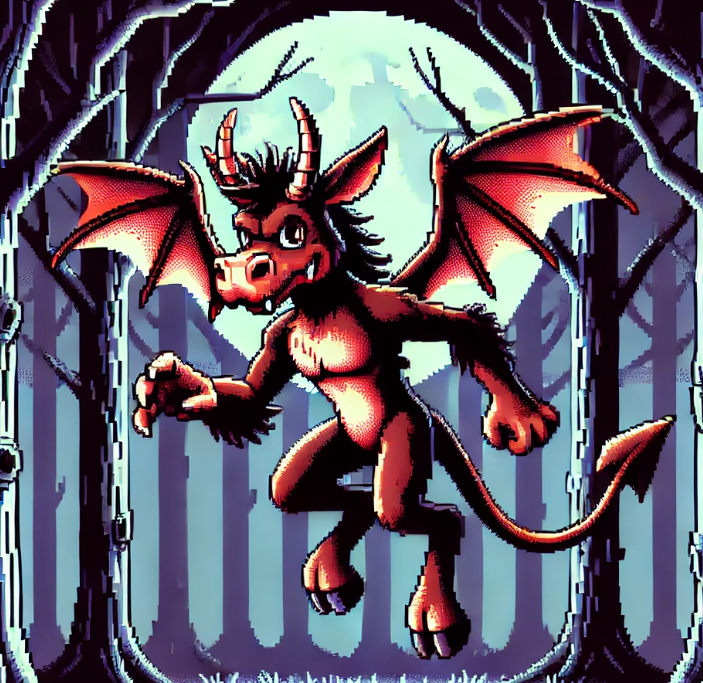
The Jersey Devil: Myth, Legend, and Politics
In the heart of New Jersey’s Pine Barrens, a creature lurks in the shadows of folklore—the Jersey Devil. With its horse-like head, bat-like wings, and clawed hands, this legendary beast has fascinated and frightened locals for generations. But what lies beneath this chilling tale? Is it merely a figment of overactive imaginations, or does it hold deeper historical significance?
We just wrote about the Pine Barrens yesterday, so let’s take a look at this region’s more legendary aspects.
A Creature Born of Folklore
The legend of the Jersey Devil begins with Mother Leeds, a figure shrouded in mystery and fear. According to the tale, Mother Leeds gave birth to her thirteenth child one stormy night in 1735. The child, said to be cursed from birth, transformed into a grotesque creature and flew up the chimney, vanishing into the Pine Barrens. This child, now known as the Jersey Devil, has since become an iconic figure in New Jersey folklore, reportedly haunting travelers and causing mischief throughout the region.
Unraveling the Historical Threads
Despite the fantastical elements of the story, the legend of the Jersey Devil is rooted in historical events and real people. The Leeds family, particularly Daniel Leeds, played a significant role in the development of this myth. Daniel Leeds was a prominent figure in colonial New Jersey, known for his almanacs and controversial views that often put him at odds with the Quaker community.
Daniel Leeds’ almanacs, which included astrological symbols and pagan references, were considered scandalous by some Quakers. His publications and outspoken criticisms of Quakerism led to his ostracization and fueled rumors and accusations against him. These conflicts, combined with the political and religious tensions of the time, contributed to the transformation of the Leeds family’s reputation into something sinister.
Political and Religious Intrigue
The legend of the Jersey Devil is not just a ghost story; it reflects the political and religious struggles of colonial New Jersey. Daniel Leeds’ alignment with the Anglican Church and his support for the Royal Governor, Lord Cornbury, further alienated him from the Quaker community. This political divide exacerbated the tension, with Leeds being painted as a heretical figure and eventually as a devil.
In his pamphlets, Leeds attacked the Quaker leadership, accusing them of various misdeeds and challenging their authority. This led to a pamphlet war, with both sides exchanging sharp critiques and personal attacks. Caleb Pusey, a prominent Quaker, labeled Leeds as “Satan’s Harbinger,” a title that stuck and evolved into the myth of the Leeds Devil.
The Birth of a Legend
By the early 20th century, the myth of the Jersey Devil had taken on a life of its own. Media coverage in the early 1900s, particularly the reports of strange hoof prints found in the snow, reignited public interest in the creature. These reports, coupled with sensationalist journalism, solidified the Jersey Devil’s place in American folklore.
The 1909 flap, which saw widespread reports of the creature across New Jersey and Pennsylvania, added new layers to the legend. Newspaper articles and dime museum exhibitions capitalized on the hysteria, presenting the Jersey Devil as a real, tangible threat. The creature was described in vivid detail, often depicted with dragon-like features and an eerie, otherworldly presence.
Debunking the Myth
Despite numerous expeditions and investigations, no concrete evidence of the Jersey Devil’s existence has ever been found. Skeptics argue that the sightings and footprints are the result of misidentifications, hoaxes, or natural phenomena. The dark, dense forests of the Pine Barrens, with their strange noises and shadows, provide a perfect backdrop for the human imagination to run wild.
Historians and folklorists suggest that the Jersey Devil legend serves as a cultural expression of the anxieties and conflicts of colonial New Jersey. It is a testament to how stories evolve, blending historical facts with fiction to create enduring myths.
Conclusion
The Jersey Devil remains a captivating figure in American folklore, embodying the fears and intrigues of colonial New Jersey. While the creature itself may not be real, the legend offers a fascinating glimpse into the historical and cultural landscape of the time. The story of the Jersey Devil is a reminder of how myths are born, shaped by political, religious, and social forces, and how they continue to capture our imaginations.
What do you think?
- How do you think political and religious conflicts shape local legends and folklore?
- What are some other examples of myths or legends that have historical roots similar to the Jersey Devil?
Feed Your Curiosity:
Discover the latest scientific research and inspiring discoveries with ‘This Week in Science’! Perfect for educators and avid learners, our free weekly newsletter is a rich source of knowledge to enhance your teaching and learning journey. Subscribe now!
About the Author
Dr. Jonathan P. Scaccia, PhD, is a clinical-community psychologist with expertise in public health science and practice. He has led evaluation and research initiatives focusing on health equity, vaccine distribution, and organizational readiness. Dr. Scaccia has contributed to federal suicide prevention programs and vaccine equity strategies. He has been recognized for his impactful work and is a leading voice in advancing public health practices.



